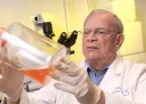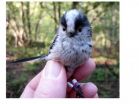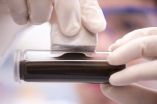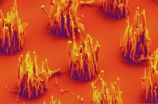(Press-News.org) When it comes to detecting deceit, your automatic associations may be more accurate than conscious thought in pegging truth-tellers and liars, according to research published in Psychological Science, a journal of the Association for Psychological Science.
The findings suggest that conscious awareness may hinder our ability to detect whether someone is lying, perhaps because we tend to seek out behaviors that are supposedly stereotypical of liars, like averted eyes or fidgeting. But those behaviors may not be all that indicative of an untrustworthy person.
"Our research was prompted by the puzzling but consistent finding that humans are very poor lie detectors, performing at only about 54% accuracy in traditional lie detection tasks," explains psychological scientist and study author Leanne ten Brinke, postdoctoral fellow at the University of California, Berkeley's Haas School of Business.
That's hardly better than chance, as if participants were simply guessing whether the person was lying. And it's a finding that seems at odds with the fact that humans are typically sensitive to how others are feeling, what they're thinking, and what their personalities are like.
Along with UC Berkeley colleague Dayna Stimson and Berkeley-Haas Asst. Prof. Dana Carney, ten Brinke hypothesized that these seemingly paradoxical findings may be accounted for by unconscious processes:
"We set out to test whether the unconscious mind could catch a liar – even when the conscious mind failed," she says.
The researchers first had 72 participants watch videos of "suspects" in a mock-crime interview. Some of the suspects in the videos had actually stolen a $100 bill from a bookshelf, whereas others had not. However, all of the suspects were instructed to tell the interviewer they had not stolen the money. In doing so, one group of suspects must have been lying, whereas the other group must have been telling the truth.
When the 72 participants were asked to say which suspects they thought were lying and which were telling the truth, they were pretty inaccurate: They were only able to detect liars 43% of the time, and truth-tellers only 48% of the time.
But the researchers also employed widely-used behavioral reaction time tests (one of which is called the Implicit Association Test or IAT) to probe participants' more automatic instincts towards the suspects.
Results showed that participants were more likely to unconsciously associate deception-related words (e.g. "untruthful," dishonest," and "deceitful") with the suspects who were actually lying. At the same time, participants were more likely to associate truthful words (e.g. "honest" or "valid") with the suspects who were actually telling the truth.
A second experiment confirmed these findings, providing evidence that people may have some intuitive sense, outside of conscious awareness, that detects when someone is lying.
"These results provide a new lens through which to examine social perception, and suggest that – at least in terms of detection of lies – unconscious measures may provide additional insight into interpersonal accuracy," says ten Brinke.
INFORMATION:
For more information about this study, please contact: Leanne ten Brinke at leannetenbrinke@berkeley.edu.
The article abstract is available online: http://pss.sagepub.com/content/early/2014/03/19/0956797614524421.abstract
Data concerning the accuracy results reported in Experiments 1 and 2 can be found at the following URLs: http://www.leannetenbrinke.com/publications.html and http://faculty.haas.berkeley.edu/dana_carney/vita.html.
The videos used and the data that describe the cortisol reactivity, self-reported stress, and nonverbal cues to deception of the liars and truth tellers in the mock-crime scenario are available from the authors. The complete Open Practices Disclosure for this article can be found at http://pss.sagepub.com/content/by/supplemental-data.
This article has received badges for Open Data and Open Materials. More information about the badges can be found at https://osf.io/tvyxz/wiki/view/ and http://pss.sagepub.com/content/25/1/3.full/.
The APS journal Psychological Science is the highest ranked empirical journal in psychology. For a copy of the article "Some Evidence for Unconscious Lie Detection" and access to other Psychological Science research findings, please contact Anna Mikulak at 202-293-9300 or amikulak@psychologicalscience.org.
The unconscious mind can detect a liar -- even when the conscious mind fails
2014-03-24
ELSE PRESS RELEASES FROM THIS DATE:
Leaders are wired to be task-focused or team-builders, but can be both
2014-03-24
What sort of leader are you? Do you think leading is all about a laser-like focus on the task, watching the bottom line and making sure everyone is doing what they should? Or is it about listening to your team, being open to ideas and perspectives, and inspiring them to find their own niche?
Distinctions between a task-oriented leader and a social-emotional leader have filled the pages of academic literature for more than a half-century. But recent research strongly suggests the distinction has a foundation in our brains—which allows us to be either analytical or empathetic, ...
Want to survive the zombie apocalypse? This 'cologne' could be the key (video)
2014-03-24
WASHINGTON, March 24, 2014 — If you believe the doomsayers, a zombie apocalypse is coming, and you need to be prepared. On AMC's The Walking Dead, whose season finale airs Sunday, survivors are always worried about running out of bullets, arrows or even sharp sticks. But what if chemistry could help you get away from the flesh eaters? In the American Chemical Society's (ACS') latest Reactions video, we talk with chemist Raychelle Burks, Ph.D., who shares her recipe for a "death cologne" that might someday save you from the undead. The video is available at http://www.youtube.com/watch?v=SUEjmyisz7c.
INFORMATION:
Subscribe ...
Gene expression signature reveals new way to classify gum disease
2014-03-24
NEW YORK, NY (March 21, 2014) — Researchers at Columbia University Medical Center (CUMC) have devised a new system for classifying periodontal disease based on the genetic signature of affected tissue, rather than on clinical signs and symptoms. The new classification system, the first of its kind, may allow for earlier detection and more individualized treatment of severe periodontitis, before loss of teeth and supportive bone occurs. The findings were published recently in the online edition of the Journal of Dental Research.
Currently, periodontal disease is classified ...
Inherited mutated gene raises lung cancer risk for women, those who never smoked
2014-03-24
DALLAS – March 21, 2014 – People who have an inherited mutation of a certain gene have a high chance of getting lung cancer — higher, even, than heavy smokers with or without the inherited mutation, according to new findings by cancer researchers at UT Southwestern Medical Center. Although both genders have an equal risk of inheriting the mutation, those who develop lung cancer are mostly women and have never smoked, the researchers found.
People with the rare inherited T790M mutation of the epidermal growth factor receptor (EGFR) gene who have never smoked have a one-in-three ...
Researcher: Study on element could change ballgame on radioactive waste
2014-03-24
TALLAHASSEE, Fla. — Groundbreaking work by a team of chemists on a fringe element of the periodic table could change how the world stores radioactive waste and recycles fuel.
The element is called californium — Cf if you're looking at the Periodic Table of Elements — and it's what Florida State Professor Thomas Albrecht-Schmitt, the lead researcher on the project, calls "wicked stuff."
In carefully choreographed experiments, Albrecht-Schmitt and his colleagues found that californium had amazing abilities to bond and separate other materials. They also found it was extremely ...
Nasal spray delivers new type of depression treatment
2014-03-24
(Toronto) March 24, 2014 – A nasal spray that delivers a peptide to treat depression holds promise as a potential alternative therapeutic approach, research from the Centre for Addiction and Mental Health (CAMH) shows.
The study, led by CAMH's Dr. Fang Liu, is published online in Neuropsychopharmacology.
In a previous study published in Nature Medicine in 2010, Dr. Liu developed a protein peptide that provided a highly targeted approach to treating depression that she hopes will have minimal side effects. The peptide was just as effective in relieving symptoms when ...
Life hots up for British birds
2014-03-24
Climate change may be bad news for billions, but scientists at the University of Sheffield have discovered one unlikely winner – a tiny British bird, the long-tailed tit.
Like other small animals that live for only two or three years, these birds had until now been thought to die in large numbers during cold winters. But new research suggests that warm weather during spring instead holds the key to their survival.
The findings come from a 20-year study of long-tailed tits run by Professor Ben Hatchwell at the Department of Animal and Plant Sciences. The recent work ...
Biased sex ratios predict more promiscuity, polygamy and divorce in birds
2014-03-24
Birds in female-dominated populations are more likely to ditch and 'divorce' their mates while promiscuity increases in predominantly male environments, according to new research.
A joint study by the University of Sheffield and the University of Bath gives the first conclusive proof that rates of divorce and infidelity in birds are affected by the adult sex ratio of the population they live in – a theory previously discounted by biologists.
The study, which examined the pair bonding and mating behaviour of 197 different species of bird, found the divorce rate was higher ...
Recovering valuable substances from wastewater
2014-03-24
Not only plants, but also humans and animals need phosphorus, which is a building block of DNA. Many biological processes in our body can only take place if phosphorus atoms are also present. But farmers and industrial enterprises use so much of this element that soil is over-fertilized and waterways are contaminated.
This is where the experts of the German Phosphorus Platform DPP come in. As they have made it their aim to recover the phosphorus from the water, on the one hand in order to protect the environment and on the other to reutilize this valuable raw material ...
Researchers grow carbon nanofibers using ambient air, without toxic ammonia
2014-03-24
Researchers from North Carolina State University have demonstrated that vertically aligned carbon nanofibers (VACNFs) can be manufactured using ambient air, making the manufacturing process safer and less expensive. VACNFs hold promise for use in gene-delivery tools, sensors, batteries and other technologies.
Conventional techniques for creating VACNFs rely on the use of ammonia gas, which is toxic. And while ammonia gas is not expensive, it's not free.
"This discovery makes VACNF manufacture safer and cheaper, because you don't need to account for the risks and costs ...





